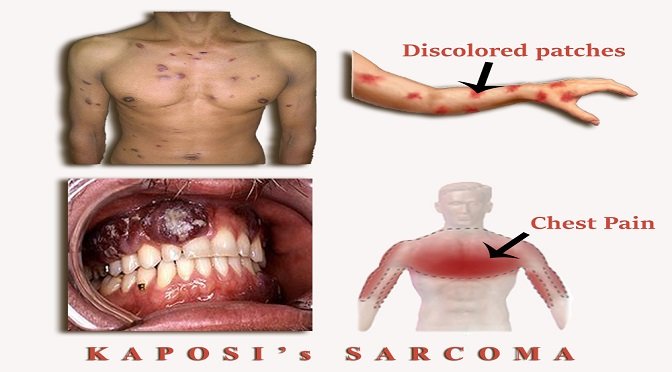
- Call: +91 9811261709
- |
- OPD Consultation
- |
- Online Consultation

- Call: +91 9811261709
- |
- OPD Consultation
- |
- Online Consultation
Kaposi Sarcoma

Kaposi’s sarcoma is a rare type of cancer caused by a virus called Human Herpesvirus-8 (HHV-8), also known as the Kaposi’s sarcoma- Associated Herpes virus (KSHV). This cancer is mostly seen in people with an advanced HIV infection, people with a weakened immune system and for another reason, such as after having an organ transplant. Dr. Sameer Kaul , Sr Consultant Surgical Oncology & Robotics , Apollo Cancer Institue, New Delhi, discusses the different types of Kaposi’s sarcoma , Symptoms, Diagnosis ,treatment ,and risk factors at length.
AIDS
Human Immunodeficiency Virus (HIV) the virus that causes AIDS have the highest risk of Kaposi’s sarcoma. A weak immune system due to HIV allows cells harboring HHV-8 to multiply. Before AIDS epidemic Kaposi’s sarcoma was rare ,During the AIDS epidemic Kaposi’s sarcoma increased more than 20 times there are 6 cases per million per year.
Weakened Immune System
A weakened immune system allows the HHV-8 virus to multiply to high levels in the blood, increasing the chance of it causing Kaposi’s sarcoma. The virus appears to alter the genetic instruction that control cell growth. It affects the endothelial cells, which line the inner surface of blood vessels and lymphatic vessels.
Transplant’s Kaposi’s sarcoma
This is a rare complication of an organ transplant. After an organ transplant, you are given medication called immunosuppressant to prevent your body rejecting the donated organ.
Endemic or African Kaposi’s sarcoma
This is common in parts of African where the HHV-8 infection is widespread. In many cases, it’s caused by an undiagnosed HIV Infection, and HIV Medication is the most effective treatment.
Classic Kaposi’s sarcoma
This is very rare and mainly affects the skin on the lower legs and feet.
Symptoms of Kaposi’s sarcoma
Most Common initial Symptoms are Small, discoloured patches on skin or in the mouth.
Uncomfortable swelling in the arms or legs (Lymphedema).
Breathlessness, coughing up blood, chest pain, nausea, vomiting, stomach pain and diarrhoea.
Lymphedema
Physical Examination
Predilection for face (nose), oral cavity, feet.
Carefully inspect face, around eyes, around ears.
Look at hard palate and gums.
Examine lymph nodes.
Look at dorsal and plantar aspect of feet.
Look for woody lymphedema of legs.
Diagnosis of Kaposi’s sarcoma
Main method of diagnosing is biopsy. A sample of affected tissue is taken and checked under a microscope. The procedure is performed under local anaesthesia.
Skin, lung and GI tract tests used to detect and diagnose Kaposi’s sarcoma.
Blood test is used to see if the cancer has spread.
Other test includes HIV tests, CT scan etc.
Upper endoscopy can be done to examine the esophagus, stomach and the small intestine, A long, thin, flexible tube with a light and camera at one end (an endoscope) is passed through the patient’s mouth .If doctor suspects Kaposi’s sarcoma a biopsy of the affected tissue can be done to confirm the disease.
Colonoscopy can be done to examine the walls of rectum and colon, a thin tube (colonoscope) is passed through the patient’s rectum and advanced into colon to examine . If any abnormalities found during the colonoscopy, rectum or colon can be biopsied during.
Treatment
This disease is one of the main types of cancer to affect people with HIV. It can progress very quickly if not treated. It can usually be treated very effectively by taking HIV medication known as combination antiretroviral therapy (ART).
Electrodessication(Burning),Cryotherapy (Freezing), surgery , radiation, chemotherapy drug vinblastine directly into lesionsApplication of retinoid(vitamin A-like drug )
Read more
Epidemic (HIV/AIDS- related) Kaposi’s sarcoma and non Epidemic Kaposi’s sarcoma
Classic (Mediterranean) Kaposi’s sarcoma
Endemic (African) Kaposi’s sarcoma
Latrogenic (Transplant- related) Kaposi’s sarcoma

Search
Latest 5 Posts
- Medical Marijuana in Cancer
- Kaposi Sarcoma
- Dealing with Chemotherapy
- Managing Scan-Related Anxiety
- Chemoports: Toll Roads in Cancer Treatment
Categories
- Cancer Conferences
- Cancer Education Resource
- Cancer Workshop
- News & Media
- OPD
- PIPAC State of the Art
Monthly Archives
Tags
- apollo cancer institutes
- best breast cancer doctor delhi
- best breast cancer specialist delhi
- best cancer doctor delhi
- best cancer specialist delhi
- best surgical oncologist delhi
- breast cancer
- breast cancer doctor
- breast cancer doctor delhi
- breast cancer doctor sameer kaul
- breast cancer patient benefit foundation
- breast cancer specialist
- breast cancer specialist delhi
- breast cancer treatment delhi
- cancer
- cancer camp bihar
- cancer camp gopalganj
- cancer camp guwahati assam
- cancer care delhi
- cancer care team delhi
- cancer conference assam
- cancer conference guwahati
- cancer conference north east india
- cancer doctor
- cancer doctor delhi
- cancer doctor dr sameer kaul delhi
- cancer specialist
- cancer specialist delhi
- cancer specialist dr sameer kaul
- cancer specialists
- cancer specialist sameer kaul
- cancer stomach cavity
- cancer surgeon dr sameer kaul
- cancer treatment delhi
- dr feroz pasha
- dr feroz pasha cancer specialist
- dr sameer kaul
- dr sameer kaul cancer specualist
- lung cancer specialist delhi
- sameer kaul
- sameer kaul breast cancer doctor delhi
- sameer kaul breast cancer specialist
- stomach cancer survivor
- surgical oncologist
- surgical oncologist delhi